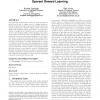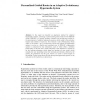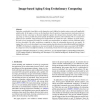5114 search results - page 104 / 1023 » Learning for Evolutionary Design |
GECCO
2009
Springer
15 years 2 months ago
2009
Springer
An agent that deviates from a usual or previous course of action can be said to display novel or varying behaviour. Novelty of behaviour can be seen as the result of real or appar...
BIBE
2007
IEEE
15 years 4 months ago
2007
IEEE
—High-throughput data such as microarrays make it possible to investigate the molecular-level mechanism of cancer more efficiently. Computational methods boost the microarray ana...
112
click to vote
EUROCAST
2003
Springer
15 years 3 months ago
2003
Springer
In this paper we describe an adaptation method for adaptive hypermedia systems, consisting in personalized guided routes for the SEM-HP model. SEM-HP is a layered, systemic, semant...
CGF
2008
14 years 10 months ago
2008
Aging has considerable visual effects on the human face and is difficult to simulate using a universally-applicable global model. In this paper, we focus on the hypothesis that th...
GECCO
2007
Springer
15 years 4 months ago
2007
Springer
Surrogate-Assisted Memetic Algorithm(SAMA) is a hybrid evolutionary algorithm, particularly a memetic algorithm that employs surrogate models in the optimization search. Since mos...




